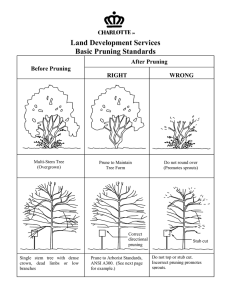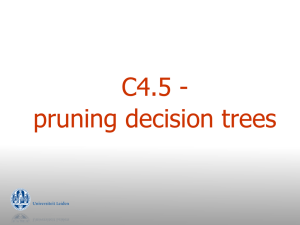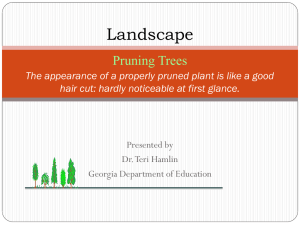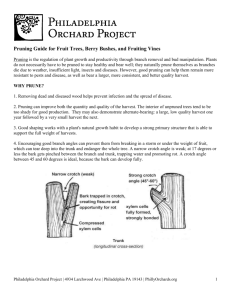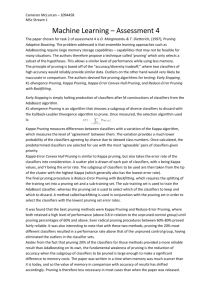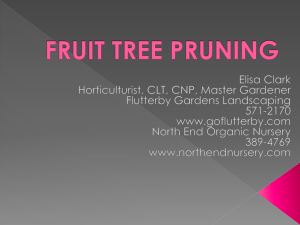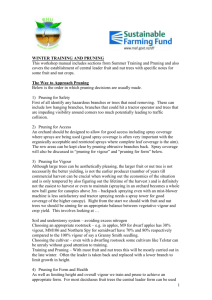Pruning
advertisement
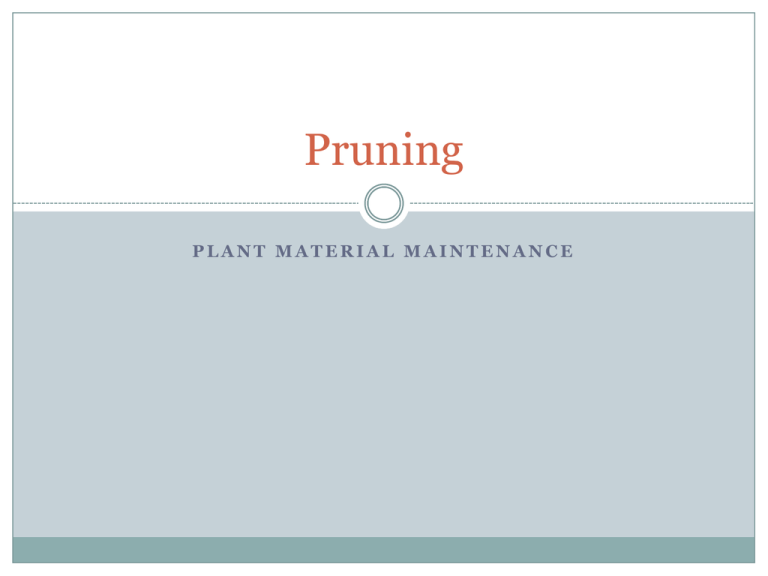
Pruning PLANT MATERIAL MAINTENANCE Pruning Both an art and a science. Principle of apical dominance A naturally occurring plant hormone IAA is produced by the terminal (apical) bud. High concentrations of IAA inhibit the growth of lateral buds. Removing the terminal bud during pruning removes the source of IAA. As the concentration of IAA in the stem decreases lateral buds “break” and push new growth. Terminal Bud Terminal Bud Bud break on Vitis Pruning Objectives Reducing the potential for tree or branch failure. Providing clearance. Reducing shade and wind resistance. Maintaining health and structure. Flower or fruit production. Improving visibility. Aesthetics. Tree failure Pruning for power line clearance Pruning to reduce wind resistance The 3-D’s of pruning to maintain tree health and structure Dead Diseased Dysfunctional A few examples of dysfunctional branches A. B. C. D. E. F. G. H. Suckers. Stubs or broken branches. Downward-growing branches. Rubbing or crisscrossing branches. Shaded interior branches. Competing leaders. Narrow crotches. Whorls. The desired outcome: a central leader with well-spaced scaffold (lateral) branches Dormant pruning fruit trees Espaliered apple trees Espaliered apple tree trained to grow on the side a house Pruning for improved visibility Topiary: An example of pruning for aesthetics An espaliered Ginkgo tree Pruning annual and herbaceous perennial plants Pinching Using your fingers to remove terminal shoot growth. Deadheading Removing “spent” flowers. Pruning trees and shrubs Some important pruning terminology: Branch collar Branch bark ridge Codominant stems Included bark The collar is formed by overlapping branch and trunk wood. Inside the collar on most trees is a unique barrier called the “branch protection zone”. This zone has chemical and physical properties that retard the spread of decay into the trunk. The presence of a branch collar is a sign of strong branch attachment. Branch collar A raised area of bark tissue found at the union of a branch and stem. Branch bark ridge Two stems with nearly the same diameter originating from the same union. Codominant stems do not form a branch collar and lack a branch protection zone. Codominant stems Included bark is bark that has been pinched or embedded between two stems or between a branch and trunk. It is an indication of a weak branch union. Included bark More on the “branch protection zone”… From work first done by Dr. Alex Shigo. CODIT Trees don’t heal, they seal! The anatomy of a 3-year old tree stem Branch Protection Zone • Found in the intact branch collar • Chemical changes in the cells seal-off or “compartmentalize” the wounded area Wound healing will always be more successful when the cut is made at a branch collar. Types of pruning cuts Reduction cut Removal cut Heading cut A reduction cut reduces the length of a branch or stem back to a live lateral branch large enough to assume apical dominance – this is at least 1/3 the diameter of the cut stem. Reduction cut Making a reduction cut in the right place A removal cut removes a branch from the trunk or parent branch and is made to a branch collar. Removal cut Making a removal cut in the right place Use the 3-step pruning cut for larger branches Use for branches that are too big to support with your hand Reduces weight of branch before final cut. 1st cut- up from bottom, 6”12” out 2nd cut-down from top, outside 1st cut 3rd cut- final cut. Near trunk, leaving branch collar intact. 2 1 3 See what happens when you don’t use the 3-step cut… A heading cut also reduces the length of a stem or branch. The cut may be made to a predetermined length or back to a bud. Heading cut When to prune trees? Remove dead and diseased branches at any time. Live branches are best pruned during the dormant season. A light pruning, removing 10% or less of the foliage, can be performed safely on most species at any time. It is not advised to prune oaks during the growing season. Shearing Informal Barberry hedge Informal Arrowwood Viburnum hedge Shearing involves removing several inches of the current seasons growth flush. Shearing is used to create and maintain formal hedges or shape plants. This formal hedge is maintained by shearing Shearing Boxwood before shearing Boxwood after shearing Proper hedge shape: it’s all about light Manual or gas-powered hedge shears Manual Gas-powered Renovation pruning of shrubs Renovation pruning involves “thinning” a shrub by removing approximately 1/4 - 1/3 of the stems. Stems selected for removal include older, large diameter stems and any diseased or damaged stems. Heading cuts can also be made to reduce the height of the shrub. Renovation pruning Compact Burning Bush prior to renovation Compact Burning Bush after renovation Shrub rejuvenation Shrub rejuvenation involves cutting a shrub back nearly to the ground in early spring before growth. This type of pruning is done on old plants that lack vigor and those that have become too large for their location. Deciduous shrubs that benefit from rejuvenation pruning include shrub dogwoods (Cornus), forsythia (Forsythia), honeysuckle (Lonicera), spirea (Spiraea), some viburnums (Viburnum), weigela (Weigela) and other fast growing ornamentals. Be aware that all plants do not respond to this type of pruning so do a little research before trying this technique. Variegated Willow 3 weeks after a rejuvenation pruning The End
